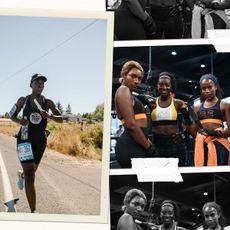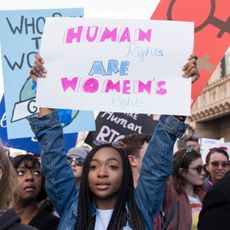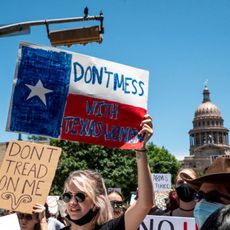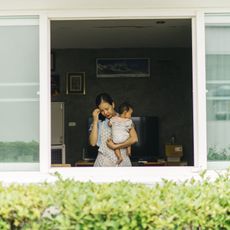
In August, shocking images of the U.K. riots flashed around the world: a woman leaping from a burning building, a hooded mob looting H&M, a police car in flames. The riots, sparked by the police shooting of a London man during an arrest, raged for six days, spreading across London and into other cities around the country. The result: an estimated $160 million in destroyed property and lost business. Five people died, and 111 police officers were injured. But the real shocker? A large percentage of the looters were women.
Of the nearly 3,000 arrests made during the chaos, an estimated 10 percent were women — from two very different worlds. Some of the ladies were the last people you would expect to see looting stores for sneakers or snacks. The most prominent was Laura Johnson, the 19-year-old daughter of a millionaire and a student at the posh Exeter University. She was alleged to have been in a car that contained around $8,000 worth of looted electronics. She pleaded not guilty and was granted bail on the condition that she wear an electronic GPS tag on her ankle, ensuring that she sticks to a nightly curfew. In a similar story, Adrienne Ives watched the TV news in horror as she recognized her 18-year-old daughter, Chelsea, in the thick of the riots. The teenager, a celebrated track-and-field athlete, had been chosen to serve as an Olympic ambassador, to greet visitors as they arrive at the 2012 London games. She was charged with violent disorder, including throwing bricks at a police car. She was stripped of her ambassador role and could face jail time.
In the other camp were women who were neither academic highfliers nor pillars of the community. Take, for instance, 22-year-old Shereka Leigh, an unemployed mother of one, caught trying on sneakers amid the looting in popular retailer JD Sports. Recently evicted from her apartment, she fit the widely held belief that the looters were alienated young people from deprived inner-city neighborhoods. Ninety percent of the looters were neither working nor attending school, The Guardian reported. Many were reportedly in gangs.
A young woman named Charmain Humphreys, a youth worker at an East London charity called Immediate Theatre, explains that often, women get coerced into looting by their gangster boyfriends. "One girl was given no choice by her boyfriend. He said: 'You're my girlfriend — you have to go looting with me,'"says Humphreys. Young women regularly assist their gangland boyfriends in an array of robberies, she adds. For instance, a young woman will be enlisted to befriend a drug dealer who is "floss- ing," or showing off his money. The young woman will chat him up, find out where he lives, and then report that address back to the boyfriend, who then robs the dealer with his fellow gang members.
There are now an estimated 170 gangs operating in London, where police are famously unarmed. In 2009, to meet a rise in gun crime, London's specialist armed police unit, CO19, took the unprecedented step of carrying out foot patrols with submachine guns in crime hot spots like Tottenham, where the recent riots began. Perhaps as alarming as the rise in gun crime is the rise in girl crime.
Stay In The Know
Marie Claire email subscribers get intel on fashion and beauty trends, hot-off-the-press celebrity news, and more. Sign up here.
-
 Heidi Gardner Opens Up About Viral Moment She Broke Character During ‘Saturday Night Live’ Beavis and Butt-Head Sketch
Heidi Gardner Opens Up About Viral Moment She Broke Character During ‘Saturday Night Live’ Beavis and Butt-Head Sketch“I just couldn’t prepare for what I saw.”
By Rachel Burchfield Published
-
 Fashion, Family, Fitness: The 3 Guiding Principles of 'MC' Editor-in-Chief Nikki Ogunnaike and How They Intersect in Her Life
Fashion, Family, Fitness: The 3 Guiding Principles of 'MC' Editor-in-Chief Nikki Ogunnaike and How They Intersect in Her LifeBy Nikki Ogunnaike Published
-
 Caitlin Clark's WNBA Draft Glow Is Courtesy of Glossier
Caitlin Clark's WNBA Draft Glow Is Courtesy of GlossierShe even wore a just-launched product from the brand.
By Julia Marzovilla Published
-
 36 Ways Women Still Aren't Equal to Men
36 Ways Women Still Aren't Equal to MenIt's just one of the many ways women still aren't equal to men.
By Brooke Knappenberger Last updated
-
 EMILY's List President Laphonza Butler Has Big Plans for the Organization
EMILY's List President Laphonza Butler Has Big Plans for the OrganizationUnder Butler's leadership, the largest resource for women in politics aims to expand Black political power and become more accessible for candidates across the nation.
By Rachel Epstein Published
-
 Want to Fight for Abortion Rights in Texas? Raise Your Voice to State Legislators
Want to Fight for Abortion Rights in Texas? Raise Your Voice to State LegislatorsEmily Cain, executive director of EMILY's List and and former Minority Leader in Maine, says that to stop the assault on reproductive rights, we need to start demanding more from our state legislatures.
By Emily Cain Published
-
 Your Abortion Questions, Answered
Your Abortion Questions, AnsweredHere, MC debunks common abortion myths you may be increasingly hearing since Texas' near-total abortion ban went into effect.
By Rachel Epstein Published
-
 The Future of Afghan Women and Girls Depends on What We Do Next
The Future of Afghan Women and Girls Depends on What We Do NextBetween the U.S. occupation and the Taliban, supporting resettlement for Afghan women and vulnerable individuals is long overdue.
By Rona Akbari Published
-
 How to Help Afghanistan Refugees and Those Who Need Aid
How to Help Afghanistan Refugees and Those Who Need AidWith the situation rapidly evolving, organizations are desperate for help.
By Katherine J. Igoe Published
-
 It’s Time to Give Domestic Workers the Protections They Deserve
It’s Time to Give Domestic Workers the Protections They DeserveThe National Domestic Workers Bill of Rights, reintroduced today, would establish a new set of standards for the people who work in our homes and take a vital step towards racial and gender equity.
By Ai-jen Poo Published
-
 The Biden Administration Announced It Will Remove the Hyde Amendment
The Biden Administration Announced It Will Remove the Hyde AmendmentThe pledge was just one of many gender equity commitments made by the administration, including the creation of the first U.S. National Action Plan on Gender-Based Violence.
By Megan DiTrolio Published